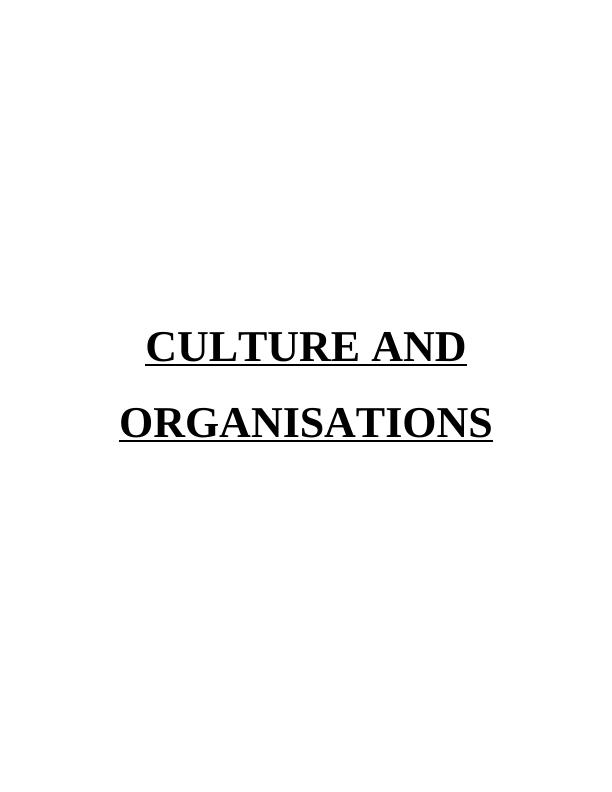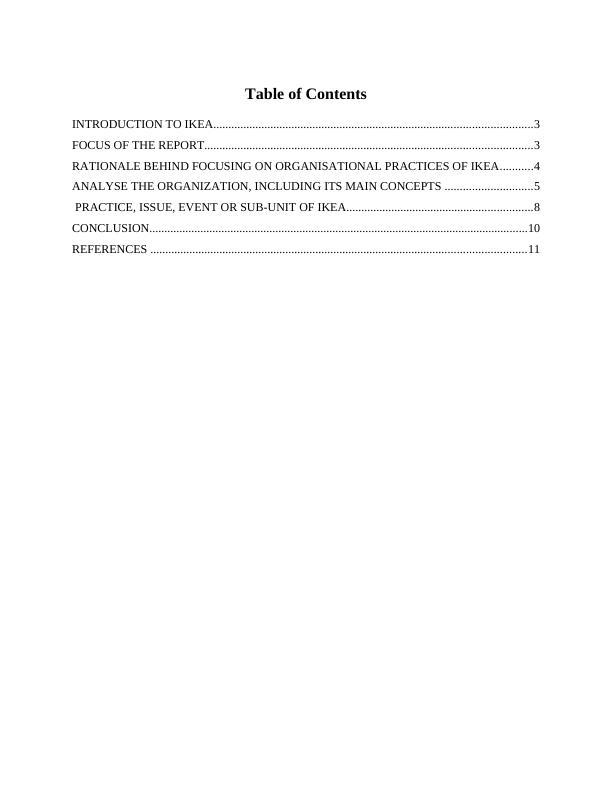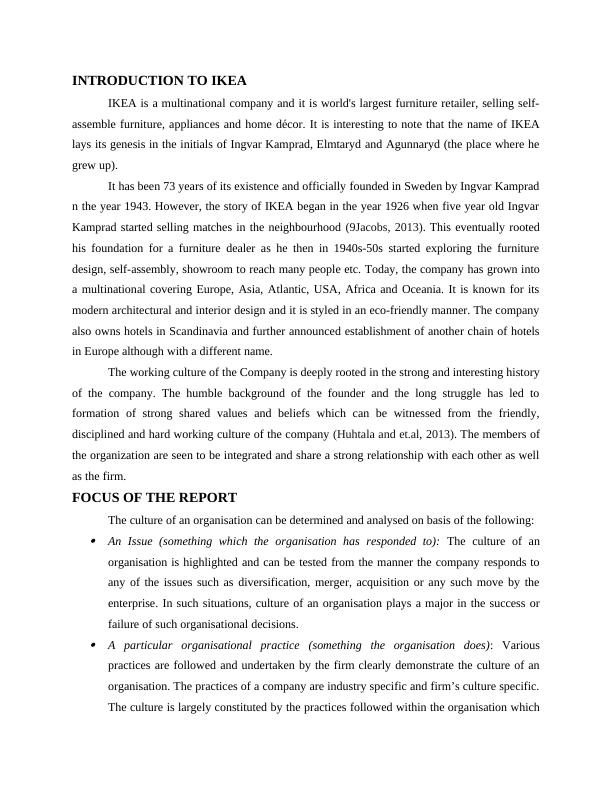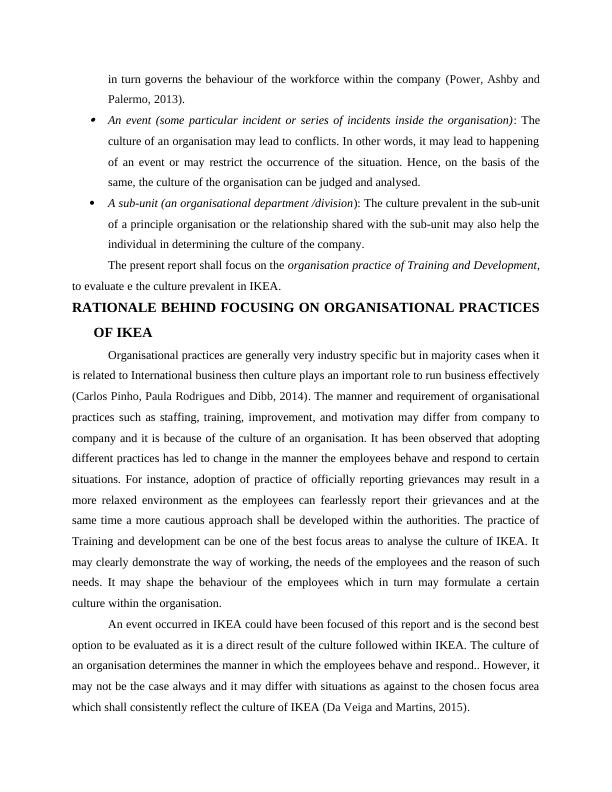Ask a question from expert
Evaluation of Culture Prevalent in IKEA
12 Pages3991 Words188 Views
Added on 2020-01-15
Evaluation of Culture Prevalent in IKEA
Added on 2020-01-15
BookmarkShareRelated Documents
CULTURE ANDORGANISATIONS

Table of ContentsINTRODUCTION TO IKEA..........................................................................................................3FOCUS OF THE REPORT.............................................................................................................3RATIONALE BEHIND FOCUSING ON ORGANISATIONAL PRACTICES OF IKEA...........4ANALYSE THE ORGANIZATION, INCLUDING ITS MAIN CONCEPTS .............................5PRACTICE, ISSUE, EVENT OR SUB-UNIT OF IKEA..............................................................8CONCLUSION..............................................................................................................................10REFERENCES .............................................................................................................................11

INTRODUCTION TO IKEAIKEA is a multinational company and it is world's largest furniture retailer, selling self-assemble furniture, appliances and home décor. It is interesting to note that the name of IKEAlays its genesis in the initials of Ingvar Kamprad, Elmtaryd and Agunnaryd (the place where hegrew up). It has been 73 years of its existence and officially founded in Sweden by Ingvar Kampradn the year 1943. However, the story of IKEA began in the year 1926 when five year old IngvarKamprad started selling matches in the neighbourhood (9Jacobs, 2013). This eventually rootedhis foundation for a furniture dealer as he then in 1940s-50s started exploring the furnituredesign, self-assembly, showroom to reach many people etc. Today, the company has grown intoa multinational covering Europe, Asia, Atlantic, USA, Africa and Oceania. It is known for itsmodern architectural and interior design and it is styled in an eco-friendly manner. The companyalso owns hotels in Scandinavia and further announced establishment of another chain of hotelsin Europe although with a different name. The working culture of the Company is deeply rooted in the strong and interesting historyof the company. The humble background of the founder and the long struggle has led toformation of strong shared values and beliefs which can be witnessed from the friendly,disciplined and hard working culture of the company (Huhtala and et.al, 2013). The members ofthe organization are seen to be integrated and share a strong relationship with each other as wellas the firm. FOCUS OF THE REPORTThe culture of an organisation can be determined and analysed on basis of the following:An Issue (something which the organisation has responded to): The culture of anorganisation is highlighted and can be tested from the manner the company responds toany of the issues such as diversification, merger, acquisition or any such move by theenterprise. In such situations, culture of an organisation plays a major in the success orfailure of such organisational decisions. A particular organisational practice (something the organisation does): Variouspractices are followed and undertaken by the firm clearly demonstrate the culture of anorganisation. The practices of a company are industry specific and firm’s culture specific.The culture is largely constituted by the practices followed within the organisation which

in turn governs the behaviour of the workforce within the company (Power, Ashby andPalermo, 2013). An event (some particular incident or series of incidents inside the organisation): Theculture of an organisation may lead to conflicts. In other words, it may lead to happeningof an event or may restrict the occurrence of the situation. Hence, on the basis of thesame, the culture of the organisation can be judged and analysed.A sub-unit (an organisational department /division): The culture prevalent in the sub-unitof a principle organisation or the relationship shared with the sub-unit may also help theindividual in determining the culture of the company. The present report shall focus on the organisation practice of Training and Development,to evaluate e the culture prevalent in IKEA.RATIONALE BEHIND FOCUSING ON ORGANISATIONAL PRACTICESOF IKEAOrganisational practices are generally very industry specific but in majority cases when itis related to International business then culture plays an important role to run business effectively(Carlos Pinho, Paula Rodrigues and Dibb, 2014). The manner and requirement of organisationalpractices such as staffing, training, improvement, and motivation may differ from company tocompany and it is because of the culture of an organisation. It has been observed that adoptingdifferent practices has led to change in the manner the employees behave and respond to certainsituations. For instance, adoption of practice of officially reporting grievances may result in amore relaxed environment as the employees can fearlessly report their grievances and at thesame time a more cautious approach shall be developed within the authorities. The practice ofTraining and development can be one of the best focus areas to analyse the culture of IKEA. Itmay clearly demonstrate the way of working, the needs of the employees and the reason of suchneeds. It may shape the behaviour of the employees which in turn may formulate a certainculture within the organisation. An event occurred in IKEA could have been focused of this report and is the second bestoption to be evaluated as it is a direct result of the culture followed within IKEA. The culture ofan organisation determines the manner in which the employees behave and respond.. However, itmay not be the case always and it may differ with situations as against to the chosen focus areawhich shall consistently reflect the culture of IKEA (Da Veiga and Martins, 2015).

End of preview
Want to access all the pages? Upload your documents or become a member.
Related Documents
Strategic Marketing Management for Ikea: Process, Models and Measureslg...
|33
|7472
|77
Managerial Economics Analysis of IKEA's Market Structurelg...
|12
|3081
|485
Managing People and Organisations: An Analysis of IKEA's Organisational Culturelg...
|12
|3036
|345
Global Sourcing Challenge: Indian Rugs and Child Labor - A Case Study Analysis on Ikealg...
|17
|4094
|462
IKEA's Social Responsibility: A Review Based on ISO26000 Standardlg...
|12
|3872
|76
Analysis of IKEAlg...
|16
|786
|34